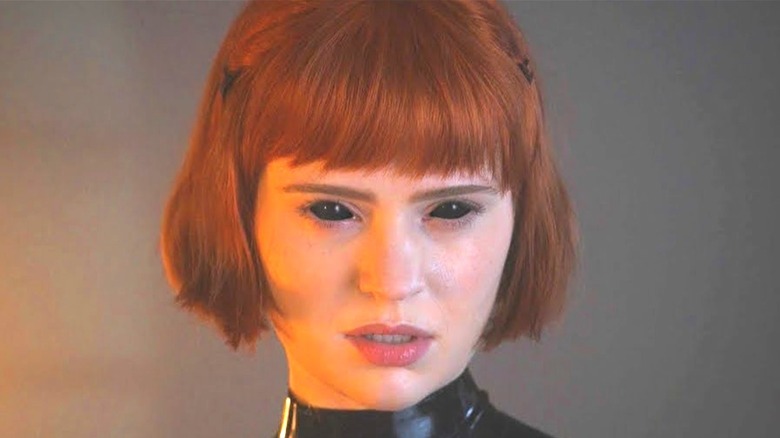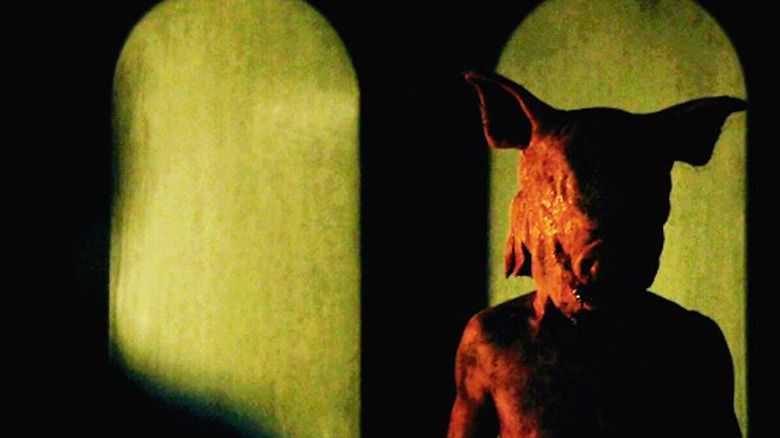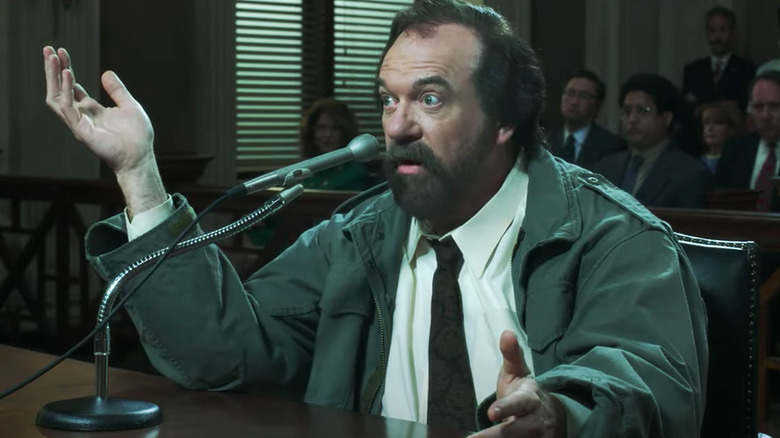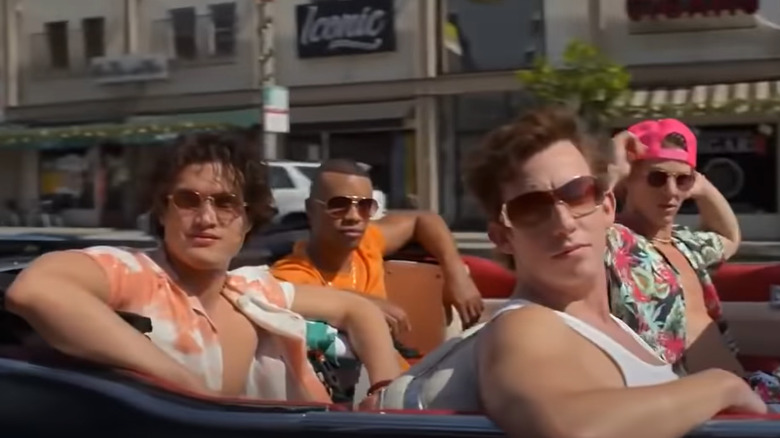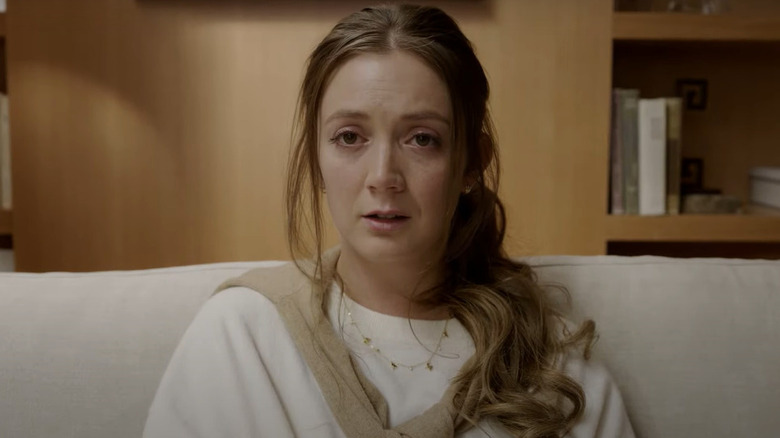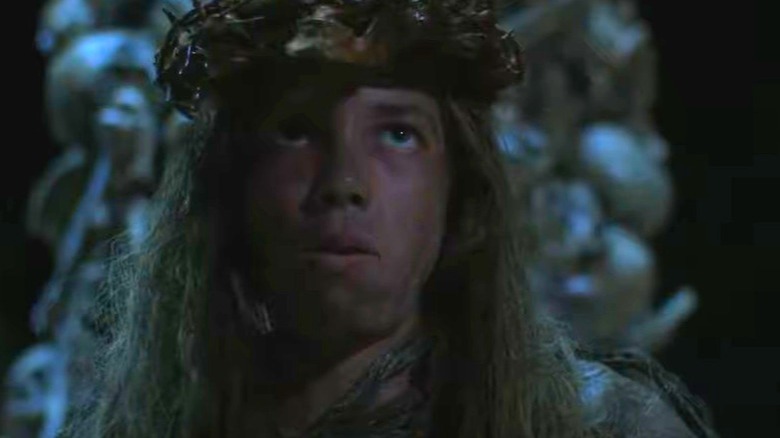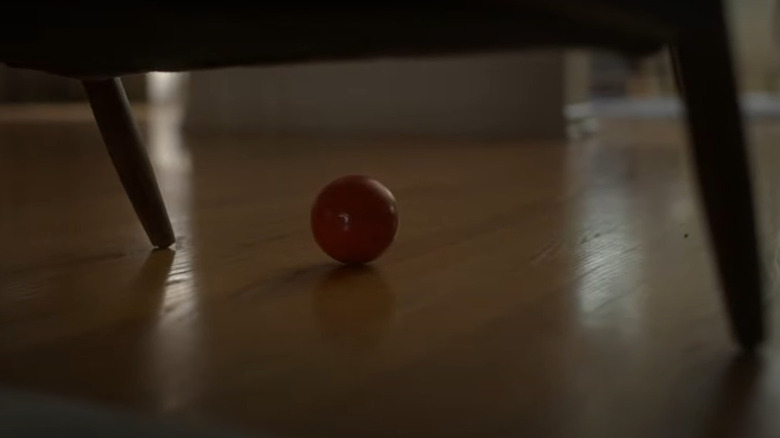The Biggest Questions Fans Have After Watching American Horror Stories
Viewers are now knee-deep into the six-episode anthology series "American Horror Stories," and fans are buzzing about every morbid new tale like bees trapped in a spider's web. However, even the most rock-solid of horror franchises — and "AHS" would definitely qualify — can sometimes elicit confusion from its loyal fanbase. As this newest series has unspooled, fans have often screamed with delight at the many thrills, callbacks to the original series, and plot twists ... but they have also encountered a few questions that have been haunting them harder than a house full of ghosts on Devil's Night.
Some of the finer details in "American Horror Stories" aren't tied up as neatly as one might hope. Will the series ever clear up these points of confusion? That remains to be seen, but here are the unsolved mysteries that, so far, have left fans scratching their heads. Beware, boys and ghouls, because there are spoilers for "American Horror Stories" (as well as the main series, "American Horror Story") coming your way.
How can the Piggy Man be a ghost in the Murder House?
"How is Piggy Man even a ghost at the house?" wondered u/sleepynatural in the AHS Reddit discussion post for the first episode "Rubber (Wo)man." It's a fine question.
Among the many ghosts we get during the multiple seasons of "American Horror Story," Piggy Man isn't the most sympathetic fellow — his stock and trade is brutality. After all, he originally deserted the Roanoke colony, swiping food on his way out, resulting in his own execution and the severed head of a pig forever being mounted upon his head. He haunts the Roanoke House, which was built over the grounds where he died, and indiscriminately murders without reason or much tactical acumen. Like the original Rubber Man and the Aliens from the "Asylum" season, he provides a memorable and arresting visual picture, but canonically it makes next to no sense to have him haunting the Murder House.
In the "Murder House" season of "American Horror Story," Piggy Man exists only as a scary urban legend, versus the "Roanoke" season where he is a physical presence. His appearance in the two-part "Rubber (Wo)man," though, raises new questions. Since "AHS" ghost lore tells us the ghosts in question are bound to the places where they have died and cannot leave those places unless it's Halloween, and the Murder House is nowhere near Roanoke geographically, how could Piggy Man physically haunt the Murder House? Was he a hallucination, or one of the ghosts playing a mind game? Or are there multiple Piggies who died in different locales, which means the Roanoke Piggy inspired some imitators?
We'll see what we learn — if anything — about the character's presence in a future episode. The final episode of the series, "Game Over," is slated to return us to the environs of "Murder House."
Why wasn't Bitterman impacted by his own film?
"Drive-In," the third episode of the series, has given fans fewer head scratchers to discuss, but there is one big one that has been raised by Comic Book Resources, message boards, and more: Why wasn't the film's director, Larry Bitterman ("AHS" mainstay John Carroll Lynch) physically affected by his own work?
"Rabid Rabbitt," the horrifying film which is central to the episode's narrative, causes every single person who views it to turn into a raving murderer and cannibal. Bitterman designed it that way, intentionally juxtaposing subliminal messaging with visuals and audio effects in a way to make anyone viewing it lose control and become a murderous fiend. But how does one direct a film like that and never become influenced by the process? Perhaps because he is the architect of the drama, and microscopically manages the processes, it means he never receives a full dose of the auditory poison which caused several audiences to massacre each other. Or does he work on the audio and visual track separately and then merge them blindly? Either way, it's not explained.
The only thing we know for certain from the episode is that Larry directed the film and subsequently viewed the film multiple times but — aside from his fervent devotion to the arts and his own selfish need to have an extent legacy — shows no sign of being warped by the process beyond behaving as your average film-obsessed auteur. If he has magical abilities or a way to avoid chugging his own poison, the show does not inform us.
How did Barry Die?
"The Naughty List," the show's fourth episode, combines Jake Paul-esque "Bro" culture as represented by a crop of selfish and almost sociopathic influencers who can and will do anything to get their viewers to turn out with a homicidal Santa Claus straight out of "Silent Night, Deadly Night." When that Santa Claus is portrayed by horror and action movie legend Danny Trejo, you know you're in for a wild ride. But even wild rides have logic gaps. Because how in the world does Barry die?
We watch as he's shot through the leg with an arrow, set on fire, and then falls into the pool, but his death takes an awfully short amount of time — frankly, it's almost comically quick. Did he drown? Was he burned to death? None of his wounds seem fatal enough before he hits the pool. Not to mention that he manages to run after he's set on fire, even though his leg wound had forced him to crawl away from his attacker. Many on the internet have found this unconvincing enough that they've even speculated that Barry didn't die, to the point where Barry actor Kevin McHale was asked to confirm his own character's death by TVLine — and he said that his own real-life friends were just as confused. "They were also like, 'Wait, did you actually die?' And I said yes. I think Barry died. It's ultimately up to Ryan Murphy, though, he can always reverse that if need be."
Barry's bizarre death (or is it?), though, is a small logic gap in a gleeful slaughtering that otherwise plays like a flawless satire on influencer culture.
Is Liv a witch?
The fifth episode of "American Horror Stories" focuses on a woman named Liv (Billie Lourd) and the deal she makes with a demonic entity to give birth to a child. Said deal was encouraged by Bernadette (Virginia Gardner) — a receptionist at the fertility clinic Liv had been employing with her husband Matt (Ronen Rubinstein). Bernadette hands Liv a totem and promises the statue will produce a child if used properly. Sure enough, Liv conceives. But motherhood proves to be difficult for her. It turns out there's a lot more going on under the surface between Matt and Bernadette, and Liv will have to fight them both if she wants to survive.
Liv does succeed handily and even manages to capture herself a demonic love slave in the process. That left fans wondering — as exemplified by a post created by u/blacklavenderbrown on the American Horror Stories subreddit — whether or not Liv is a simply intelligent woman up against some tough odds or secretly a witch familiar with the occult.
The latter seems possible. Liv's a natural at demon summoning even though she's just following a series of rituals prescribed by Bernadette (phony instructions that the receptionist concocted to get Liv out of the way). While Matt and their friends think they've successfully gaslit Liv for her money with their lies, she seems to know that BA'AL is real and will come to her aide. She's even powerful enough to force Ba'al to do her bidding — something your average Jane wouldn't have the know-how to do. Since Liv's such a quick study of handling the supernatural — and witches definitely exist in the "American Horror Story" universe already — it's a question that continues to hover over the episode.
Are there really feral people in our national parks?
"Feral" follows Jay Gantz (Aaron Tveit) and his wife, Addy (Tiffany Dupont), as they seek answers about the disappearance of their son Jacob (Colin Tandberg /Ledger Fuller). Ten years after Jacob vanishes, the Gantzes reluctantly follow a lead from a hunter named Bob (Blake Shields). He tells them he has proof Jacob was kidnapped by a drug cartel and takes them back into the belly of Kern Canyon National Park, where they had been camping the night they lost their son. Jay and Addy learn too late that Bob was lying to bilk them out of their money — and that the truth about Jacob's abduction is much more horrifying than either of them imagined.
Websites like Nerdist and Yahoo! helped soothe fans' fears over the most widely-circulated question related to the "Feral" episode's release — are there really cannibalistic societies hiding out in America's national parks? You might scoff at the idea, but fans of "AHS" believe that the episode is loosely based on the disappearance of some real children. While, tragically, no one knows what happened to the kids in the aforementioned cases, the likelihood that there are gangs of humans roaming the nation's parks eating stray tourists and making thrones of their bones is extremely unlikely.
Is the Murder House a real place in the Game Over universe?
The final episode of "American Horror Stories" gives us another mind-bending spin through the "Murder House" season. Michelle (Mercedes Mason) is a game dev who is in the middle of programming "Escape from the Murder House" — a horror game based upon the infamous titular California locale. She takes on the task of winning the favor of her son Rory (Nicolas Bechtel), but he is unimpressed. Sexism at work and Rory's response drives Michelle to create the most realistic game possible, and it seems to lead her to her death when she rents the Murder House for research purposes one Halloween night. The Murder House then meets its doom when Rory sets the place on fire. All of the tormented souls trapped within it are subsequently set free.
Or are they? This happy ending is immediately complicated by the fact that it takes place within Michelle's video game. While she finally manages to please her son, the last shot viewers see is of Beau's red rubber ball slowly rolling across Michelle and Rory's living room floor.
The plot and ending of "Game Over" has become such a headscratcher for "AHS" fans that there are several reviews (per The Wrap and The AV Club) and multiple posts on the "American Horror Stories" subreddit trying to figure out how the reality presented in the episode works. While we are told that "American Horror Story" is just a TV show in Michelle and Rory's world, we also learn that the Murder House really exists and people like the Harmons lived there. But was that just the video game's plotline? What does Beau's red ball signify? Fans of the show are still confused about it.
